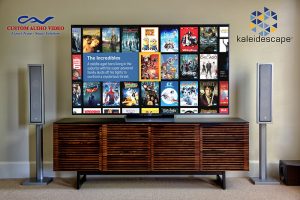The Evolution of Television Delivery
 1950: 9 percent of U.S. households enjoyed TV using over the air antennas. As the name suggests, OTA delivered content through the air using radio frequency (RF) signals which were received by antennas placed on top of their televisions. Using the antennas on the television, viewers would literally pull the signal out of the air. However, an antenna could only transmit a signal so far, and if you were not within that range, you could not get the signal.
1950: 9 percent of U.S. households enjoyed TV using over the air antennas. As the name suggests, OTA delivered content through the air using radio frequency (RF) signals which were received by antennas placed on top of their televisions. Using the antennas on the television, viewers would literally pull the signal out of the air. However, an antenna could only transmit a signal so far, and if you were not within that range, you could not get the signal.
1960: 87 percent of households now owned a TV thanks to the rise of community antenna television (CAT) better known as cable television. This system used the same RF signals but delivered the video content to individual homes using coaxial cable. Large “community antennas” were erected near communities that could not receive OTA signals due to distance or challenging/mountainous terrain, and coaxial cable was run from the community antenna to individual homes.
1972: Canada provides the first commercial North American satellite to carry television transmission. Analog Satellite TV is born. With the purchase of a satellite service, consumers were then given access to television programming via an outdoor parabolic antenna usually referred to as a satellite dish. However, much like CAT, analog satellite TV was limited to the number of channels provided by the frequency spectrum.
1990: Digital cable television and digital satellite television came upon the scene allowing both broadcasters and cable companies the ability to “shrink” the video signal needed for one channel. By doing so, multiple television channels were now able to “fit” within one analog channel frequency space. Hence, more channels.
2007: Netflix begins to blue the barrier between computer and television with the launching of a “Watch Instantly” streaming service. No longer do individuals have to wait for their D.V.D.’s to arrive by mail. Rather, they can log onto their computers and utilize the service instantly. Shortly thereafter, Apple launches Apple TV. Consumers are magically granted the ability to “watch” internet television within the comfort of their living room.
2008 and on: Hulu, Amazon Instant Video HBO Go, SHOWTIME ANYTIME, and Sling TV among others offer streaming services to consumers. As consumers are given a plethora of streaming services to choose from, digital cable television and digital satellite television are becoming a thing of the past.
….So, what’s next?
Now that we have Smart TV’s (televisions with built in streaming capabilities) as well as add-on components that we can buy (such as Apple TV and Roku), where do we go from here?
Major networks and movie studios are going to be huge game-changers. They know that they are going to have to step up their game if they want to keep the consumers interested. Already, CBS has launched an “All Access” streaming service and the other networks aren’t following far behind them. Disney has publicly shared plans to pull their content from Netflix soon, in fact, and begin their own streaming service in 2019. Other movie studios will follow suit.
Simply put, gone will be the days that you will have to purchase a pre-set package of channels just to get the few you really wanted. Instead, the future will be a la carte: you will be able to pick and choose the channels that you really want. Not only that, you will be able to watch them on your own schedule.









